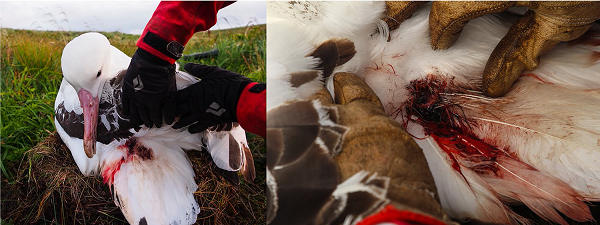 An adult Tristan Albatross with back wounds from mice; photographs (L - R) Kate Lawrence and Jaimie Cleeland
An adult Tristan Albatross with back wounds from mice; photographs (L - R) Kate Lawrence and Jaimie Cleeland
Lessons and insights from the failed mouse eradication attempt on Gough Island were presented in a recent webinar hosted by New Zealand’s Crown Research Institute, Manaaki Whenua - Landcare Research, a partner in the Gough Island Restoration Programme. The eradication attempt on the island’s introduced House Mice Mus musculus was carried out in 2021 during the southern hemisphere’s winter. Monitoring equipment captured footage of a single mouse in mid-November confirming the programme had been unsuccessful and dashing the hopes of those involved in the ambitious project.
Providing insight into the project and answering questions submitted to the webinar was Conservation Biologist and Technical Advisor to the Programme, Dr Araceli Samaniego. Dr Samaniego, who has been involved in and led a number of successful mouse eradications, outlined the eradication plan, its execution, and touched on possible reasons for its failure, including the hypothesis of invasive slugs thwarting the programme’s success. Despite the mouse population increasing quickly since the eradication attempt, Dr Samaniego believes another bid at eliminating the island’s mice would be a worthwhile venture and, due to the lessons learnt this time around, has every reason to be a success.
The 30-minute webinar, Mice squeak through eradication attempt on Gough Island - what can we learn?, is available to watch above or at the Manaaki Whenua - Landcare Research website. A transcript of the presentation and answers to questions submitted to Dr Samaniego are also available to download at the website.
For further insight on the interference of the invasive slugs during the eradication attempt, please read Dr Samaniego and colleagues' paper, “A lesson for planning rodent eradications: interference of invasive slugs during the Gough Island mouse eradication attempt in 2021”, published in the journal, Wildlife Research.
31 October 2022

 Español
Español  English
English  Français
Français